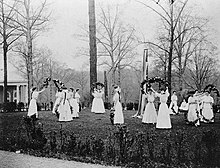Pages
_________________________________________________________________________________________
“Carpe diem! Rejoice while you are alive; enjoy the day; live life to the fullest; make the most of what you have. It is later than you think.”
__________________________________________________________________________________________________
Thursday, May 24, 2012
Wednesday, May 23, 2012
Did you know???
In Albania, nodding your head means no and shaking your head means yes.
Tuesday, May 22, 2012
Did you know???
The first open heart surgery was performed by Dr. Daniel Hall Williams in 1893.
Saturday, May 19, 2012
Did you know???
There are more than one million animal species on Earth.
Friday, May 18, 2012
Did you know???
You are born with 300 bones, but when you get to be an adult, you only have 206.
(Where do they go?? lol!)
(Where do they go?? lol!)
Thursday, May 17, 2012
INTERNATIONAL STREET FAIR(Admission is Free)
* When: May 19, 2012 - from 11am - 5pm (Usually the 3rd Saturday in May)
* Location: (Map It) Court Street in Athens, Ohio
* Phone: 740-593-4330
Athens' International Street Fair has evolved over time to become a local and regional favorite. This year's event, set for May 19, marks the conclusion to Ohio University's 2012 International Week celebration. The Street Fair, which runs from 11 am to 5 pm, is a collaboration of the university's international student groups and nonprofit community organizations. Typically, more than 30 organizations have booths at the International Street Fair to sell food, crafts etc. and there are stage performances throughout the day.
* Location: (Map It) Court Street in Athens, Ohio
* Phone: 740-593-4330
Athens' International Street Fair has evolved over time to become a local and regional favorite. This year's event, set for May 19, marks the conclusion to Ohio University's 2012 International Week celebration. The Street Fair, which runs from 11 am to 5 pm, is a collaboration of the university's international student groups and nonprofit community organizations. Typically, more than 30 organizations have booths at the International Street Fair to sell food, crafts etc. and there are stage performances throughout the day.
Wednesday, May 16, 2012
Tuesday, May 15, 2012
Literature Fact
Emily Dickinson: Recluse and poet Emily Dickinson is a commonly read and loved writer. Yet in her lifetime she was all but ignored, having fewer than a dozen poems published out of her almost 1,800 completed works.
She died today - May 15, 1886

She died today - May 15, 1886
Monday, May 14, 2012
Did you know???
If a crocodile loses his teeth it will always grow new ones to replace them.
Sunday, May 13, 2012
Did you know???
Every year about 98% of the atoms in your body are replaced.

Saturday, May 12, 2012
Did you know???
The Beatles have sold more records than anyone else with over a billion worldwide.


Did you know???
Girls have more taste buds than boys


Friday, May 11, 2012
Did you know???
A giraffe can clean its ears with its 21-inch tongue.

Thursday, May 10, 2012
HomeSchooling Facts
Homeschool Facts is the brainchild of a consortium of homeschool parents, licensed educators, counselors and researchers. We are passionate about education choice, and especially the parent's right to choose their child's education.
Years ago, when we came to homeschooling, there was little information available, and even less homeschool support. Over the past couple of years, we have collected information about and for homeschoolers. We would like to share it with you.
Please feel free to browse our shelves, complete a survey, and contribute to this collection. If you belong to a homeschool support group, please check out our state-by-state listings and make sure your group's information is up-to-date. All homeschool support group listings are FREE.
We will never claim to know everything there is to know about homeschooling, in fact, we continue to learn every day from all the homeschoolers we have met around the world. If you see something that doesn't ring true, please let us know. Your opinion counts.
It is not hard to see why. Every day there are reports about how our traditional education systems are failing to keep pace with business and industry, and indeed, worldwide education systems, in preparing our nation’s youth to enter the workforce. Students in Japan, India and China spend more time in school, and far surpass our nation’s youth in Math and Science.
Years ago, when we came to homeschooling, there was little information available, and even less homeschool support. Over the past couple of years, we have collected information about and for homeschoolers. We would like to share it with you.
Please feel free to browse our shelves, complete a survey, and contribute to this collection. If you belong to a homeschool support group, please check out our state-by-state listings and make sure your group's information is up-to-date. All homeschool support group listings are FREE.
We will never claim to know everything there is to know about homeschooling, in fact, we continue to learn every day from all the homeschoolers we have met around the world. If you see something that doesn't ring true, please let us know. Your opinion counts.
Why Homeschool:
Homeschooling is the single fastest growing educational trend in the United States, and that trend is expanding worldwide. Dr. Brian Ray, one of the leading homeschool researchers, estimates that homeschooling has increased 15% per year over the past several years. While accurate statistics regarding the number of families homeschooling is difficult to come by, Dr. Ray’s estimates are supported by the U.S. Department of Education’s National Household Education Survey program.
In 1999, the Department of Ed estimated that there were about 850,000 homeschoolers nationwide, and had increased to about 1.1 million by 2003. Ray’s estimated that there were between 1.7 and 2.1 million homeschoolers at the end of that period, and that currently, there are between 2.5 and 4 million homeschoolers nationwide.
So how do homeschoolers do, comparatively?
Socially: There is a common myth that homeschooling produces social misfits. This myth partially arises from an assumption that traditional education systems provide “normal” socialization activities. Dr. Raymond Moore, in his book Better Late than Early writes that “The idea that children need to be around many other youngsters in order to be ‘socialized’ is perhaps the most dangerous and extravagant myth in education and child rearing today." There is ample research that indicates that because home schooled students are exposed to a wider variety of people and situations, they learn to get along with a variety of people, making them socially mature and better able to adjust to new situations.
In their Communities: Many non-homeschoolers believe that homeschooling can turn out better students, but because homeschool students are educated in greater isolation from the world, they are less politically and socially involved. This concern comes at a great time, for homeschoolers at least. The first generation of homeschoolers has now grown up and entered the workforce. Dr. Ray surveyed over 7,000 adults who had been home schooled and compared them against their more traditionally educated peers. His research found that:
- Ninety-five percent of homeschoolers had an adequate comprehension of politics and government, compared to 65% of U.S. adults.
- Seventy-one percent of homeschool graduates participate in ongoing community service activities, including politics, compared to 37% of adults in similar ages.
- Eighty-eight percent of HS graduates are members of organizations (community groups, church, or professional organizations) compared to 50% of U.S. adults.
- Significantly, 76% of homeschool graduates voted in a national or state election within the past 5 years, compared to 29 percent of similar U.S. adults.
In college: Many homeschool families are concerned whether their child will be able to do well on the SAT/ACT’s and get into college. Every year, colleges across the nation and around the world are opening their doors to homeschoolers. Many of the most prestigious colleges around the nation have accepted homeschoolers: Brown, Georgetown, Harvard, MIT, Princeton, the United States Military Academy at West Point, UC at Berkeley, University of Michigan, Notre Dame, and Yale, just to name a few. Homeschool Facts has compiled a list of over 1,400 colleges that accept homeschoolers, and that list grows longer every day.
Colleges and Universities all around the nation have realized the positive benefits of attracting homeschoolers. Research indicates that homeschoolers who have gone to college have no social skill deprivation, exhibit greater leadership skills, demonstrated stronger work ethic and had higher moral values, integral in their college success.
Homeschooling is obviously not for everyone. However, it is also an education option that should be considered for any family that does not feel their student’s needs are being met in traditional educational systems. At Homeschool Facts, we are not anti-public education, we are pro-education choice. We support the parent’s right to choose which educational environment will work best for their child. As you read our pages, and ponder your options, we hope that you will find encouragement here. We appreciate your feedback.
http://www.homeschoolfacts.com/index.php
Wednesday, May 9, 2012
Tuesday, May 8, 2012
Monday, May 7, 2012
Friday, May 4, 2012
Did you know???
Half of the 42 U.S. Presidents are of Irish descent.
Thursday, May 3, 2012
Built the youngest granddarlings their own castle today - then we pretended they were a prince and princess. I was, of course, the queen.


Wednesday, May 2, 2012
Did you know???
Frogs sometimes eat enough fireflies that they themselves glow.
Tuesday, May 1, 2012
Happy May Day Everyone!!
Traditional May Day celebrations
May Day is related to the Celtic festival of Beltane and the Germanic festival of Walpurgis Night. May Day falls exactly half a year from November 1, another cross-quarter day which is also associated with various northern European pagan and the year in the Northern hemisphere, and it has traditionally been an occasion for popular and often raucous celebrations.As Europe became Christianized, the pagan holidays lost their religious character and either changed into popular secular celebrations, as with May Day, or were merged with or replaced by new Christian holidays as with Christmas, Easter, Pentecost and All Saint's Day. In the twentieth and continuing into the twenty-first century, many neopagans began reconstructing the old traditions and celebrating May Day as a pagan religious festival again.
Origins
The earliest May Day celebrations appeared in pre-Christian times, with the festival of Flora, the Roman goddess of flowers, and the Walpurgis Night celebrations of the Germanic countries. It is also associated with the Gaelic Beltane. Many pagan celebrations were abandoned or Christianized during the process of conversion in Europe. A more secular version of May Day continues to be observed in Europe and America. In this form, May Day may be best known for its tradition of dancing the maypole dance and crowning of the Queen of the May. Various Neopagan groups celebrate reconstructed (to varying degrees) versions of these customs on May 1st.The day was a traditional summer holiday in many pre-Christian European pagan cultures. While February 1 was the first day of Spring, May 1 was the first day of summer; hence, the summer solstice on June 25 (now June 21) was Midsummer. In the Roman Catholic tradition, May is observed as Mary's month, and in these circles May Day is usually a celebration of the Blessed Virgin Mary. In this connection, in works of art, school skits, and so forth, Mary's head will often be adorned with flowers in a May crowning. Fading in popularity since the late 20th century is the giving of "May baskets," small baskets of sweets and/or flowers, usually left anonymously on neighbours' doorsteps.[2]
Europe
Great Britain
Roodmas was a Christian Mass celebrated in England at midnight on May 1.The May Day bank holiday, on the first Monday in May, was traditionally the only one to affect the state school calendar, although new arrangements in some areas to even out the length of school terms mean that the Good Friday and Easter Monday bank holidays, which vary from year to year, may also fall during term time. The May Day bank holiday was created in 1978. In February 2011, the UK Parliament was reported to be considering scrapping the bank holiday associated with May Day, replacing it with a bank holiday in October, possibly co-inciding with Trafalgar Day (celebrated on 21 October), to create a "United Kingdom Day".[4]
May Day was abolished and its celebration banned by puritan parliaments during the Interregnum, but reinstated with the restoration of Charles II in 1660.[5] 1 May 1707 was the day the Act of Union came into effect, joining England and Scotland to form the Kingdom of Great Britain.

For thus it chanced one morn when all the court,
Green-suited, but with plumes that mocked the may,
Had been, their wont, a-maying and returned,
That Modred still in green, all ear and eye,
Climbed to the high top of the garden-wall
To spy some secret scandal if he might,
In Durham, students of the University of Durham gather on Prebend's Bridge to see the sunrise and enjoy festivities, folk music, dancing, madrigal singing and a barbecue breakfast. This is an emerging Durham tradition, with patchy observance since 2001.
Whitstable, Kent, hosts a good example of more traditional May Day festivities, where the Jack in the Green festival was revived in 1976 and continues to lead an annual procession of morris dancers through the town on the May Bank Holiday. A separate revival occurred in Hastings in 1983 and has become a major event in the town calendar. A traditional Sweeps Festival is performed over the May bank holiday in Rochester, Kent, where the Jack in the Green is woken at dawn on 1 May by Morris dancers.
The Maydayrun involves thousands of motorbikes taking a 55-mile (89 km) trip from London (Locksbottom) to the Hastings seafront, East Sussex. The event has been taking place for almost 30 years now and has grown in interest from around the country, both commercially and publicly. The event is not officially organised; the police only manage the traffic, and volunteers manage the parking.
Padstow in Cornwall holds its annual 'Obby-Oss' (Hobby Horse) day of festivities. This is believed to be one of the oldest fertility rites in the UK; revellers dance with the Oss through the streets of the town and even through the private gardens of the citizens, accompanied by accordion players and followers dressed in white with red or blue sashes who sing the traditional 'May Day' song. The whole town is decorated with springtime greenery, and every year thousands of onlookers attend. Prior to the 19th century distinctive May day celebrations were widespread throughout West Cornwall, and are being revived in St. Ives and Penzance.
Kingsand, Cawsand and Millbrook in Cornwall celebrate Flower Boat Ritual on the May Day bank holiday. A model of the ship The Black Prince is covered in flowers and is taken in procession from the Quay at Millbrook to the beach at Cawsand where it is cast adrift. The houses in the villages are decorated with flowers and people traditionally wear red and white clothes. There are further celebrations in Cawsand Square with Morris dancing and May pole dancing.
In St Andrews, some of the students gather on the beach late on April 30 and run into the North Sea at sunrise on May Day, occasionally naked. This is accompanied by torchlit processions and much elated celebration.
Both Edinburgh and Glasgow organize Mayday festivals and rallies. In Edinburgh, the Beltane Fire Festival is held on the evening of May eve and into the early hours of May Day on the city's Calton Hill. An older Edinburgh tradition has it that young women who climb Arthur's Seat and wash their faces in the morning dew will have lifelong beauty.
Romania
On May Day the Romanians celebrate the "arminden" (or “armindeni”), the beginning of summer, symbolically tied with the protection of crops and farm animals. The name comes from Slavonic Jeremiinŭ dĭnĭ meaning prophet Jeremiah’s day but the celebration rites and habits of this day are apotropaic and pagan (possibly originating in the cult of the god Pan). The day is also called "ziua pelinului" (mugwort day) or "ziua bețivilor" (drunkards’ day) and it is celebrated, in order to insure good wine in autumn and, for people and farm animals alike, good health and protection from the elements of nature (storms, hail, illness, pests). People would have parties in the nature with “lăutari” (fiddlers), for those who can afford. There, it is customary to roast and eat lamb, also eat new mutton cheese and drink mugwort flavoured wine or just red wine to refresh the blood and get protection from diseases. On the way back, the men wear lilac or mugwort flowers at their hats. Other apotropaic rites include, in some areas of the country, people washing their faces with the morning dew (for good health) and adorning the gates for good luck and abundance with green branches or with birch saplings (for the houses with maiden girls). The entries to the animals shelters are also adorned with green branches. All branches are left in place until the wheat harvest when they are used in the fire which will bake the first bread from the new wheat. On May Day eve, country women won’t work in the field as well as in the house to avoid devastating storms and hail coming down on the village. Arminden is also “ziua boilor” (oxen day) and thus the animals won’t be used for work, or else they could die or their owners could get ill.It is said that the weather is always good on May Day to allow people to celebrate.
Ireland
May Day has been celebrated in Ireland since pagan times as the feast of Bealtaine and in latter times as Mary's day. Traditionally, bonfires were lit to mark the coming of summer and to banish the long nights of winter. Officially Irish May Day holiday is the first Monday in May. Old traditions such as bonfires are no longer widely observed, though the practice still persists in some communities, such as Arklow, County Wicklow [9].France
On May 1, 1561, King Charles IX of France received a lily of the valley as a lucky charm. He decided to offer a lily of the valley each year to the ladies of the court. At the beginning of the 20th century, it became custom to give a sprig of lily of the valley, a symbol of springtime, on May 1. The government permits individuals and workers' organisations to sell them tax-free. Nowadays, people may present loved ones either with bunches of lily of the valley or dog rose flowers.[10]Germany
In rural regions of Germany, especially the Harz Mountains, Walpurgisnacht celebrations of pagan origin are traditionally held on the night before May Day, including bonfires and the wrapping of a Maibaum (maypole). Young people use this opportunity to party, while the day itself is used by many families to get some fresh air. Motto: "Tanz in den Mai!" ("Dance into May!"). In the Rhineland, May 1 is also celebrated by the delivery of a maypole, a tree covered in streamers to the house of a girl the night before. The tree is typically from a love interest, though a tree wrapped only in white streamers is a sign of dislike. Females usually place roses or rice in form of a heart at the house of their beloved one. It is common to stick the heart to a window or place it in front of the doormat. On leap years, it is the responsibility of the females to place the maypole. All the action is usually done secretly and it is an individual's choice whether to give a hint of their identity or stay anonymous. May Day was not established as a public holiday until 1933. As Labour Day, many political parties and unions host activities related to work and employment.Finland
Celebrations among the younger generations take place on May Day Eve, see Walpurgis Night in Finland, most prominent being the afternoon 'crowning' of statues in towns around the country with a student cap.May Day is known as Vappu, from the Swedish term. This is a public holiday that is the only carnival-style street festivity in the country. People young and old, particularly students, party outside, picnic and wear caps or other decorative clothing.
Some Finns make a special lemonade from lemons, brown sugar, and yeast called "sima". It contains very little alcohol, so even children can drink it. You can also buy a similar product in all stores. Some Finns also make doughnuts and a crisp pastry fried in oil made from a similar, more liquid dough.
Balloons and other decorations like serpentines are seen everywhere.
Sweden
The more traditional festivities have moved to the day before, Walpurgis night ("Valborgsmässoafton"), known in some locales as simply "Last of April".The first of May is instead celebrated as International Workers' Day.
Canada
May Day is celebrated in some parts of the Province of British Columbia. Celebrations often take place not on May 1 but during the Victoria Day long weekend, later in the month and when the weather is likely to be better. The honour of having the longest continually-observed May Day in the British Commonwealth -- since 1870 -- is claimed by the BC city of New Westminster.Pacific (USA)
In Hawaii, May Day is also known as Lei Day, and is normally set aside as a day to celebrate island culture in general and native Hawaiian culture in particular. Invented by a poet and a local newspaper columnist in the 1920s, it has since been adopted by state and local government as well as the residents, and has taken on the sense of a general spring celebration. The first Lei Day was proposed in 1927 in Honolulu by poet and artist Don Blanding. Leonard "Red" and Ruth Hawk composed "May Day is Lei Day in Hawai'i," the traditional holiday song. Originally it was a contemporary fox trot, later rearranged as the Hawaiian hula song performed today.United States
Modern May Day ceremonies in the U.S. vary greatly from region to region and many unite both the holiday's "Green Root" (pagan) and "Red Root" (labor) traditions.[11]
May 1 is also recognized in the U.S. as Law Day.[12]
Wikipedia
Did you know???
Polar bears can smell seal from 20 miles away
Subscribe to:
Posts (Atom)


























